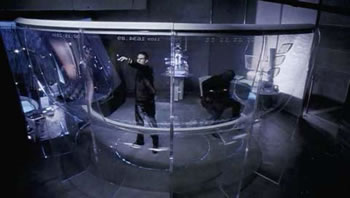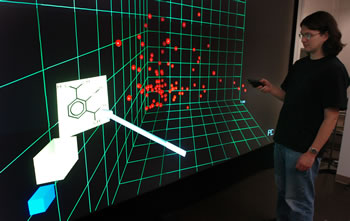Science Fiction
Dictionary
A B C D E F G H I J K L M N O P Q R S T U V W X Y Z
Minority Report-Style 'Discovery Informatics' At Purdue University

In Minority Report, Tom Cruise plays a detective who uses an immersive computer environment to solve crimes. The 'data CAVE' (Configurable Automatic Virtual Environment) brings together information from disparate souces, making it easier for detectives to see patterns and perpetrators. The film is based on Philip K. Dick's remarkable 1956 short story of the same name; in the story, the Precrime analytical wing stands by to interpret the fevered words of the three precogs (from "precognitive") who see into the future.

(Minority Report interface from the movie)
Purdue University researchers are developing a visual display environment with high-performance computers and artificial intelligence software, with interactive features similar to the display Tom Cruise works with in the film. The new 'data CAVE' takes a new approach to working with large volumes of data. James Caruthers, professor of chemical engineering at Purdue, explains:
"Instead of mining for a nugget of gold [data-mining], knowledge discovery is more like sifting through a warehouse filled with small gears, levers, etc., none of which is particularly valuable by itself. After appropriate assembly, however, a Rolex watch emerges from the disparate parts."

(From Knowledge Discovery at Purdue)
Chemical engineers are able to take huge amounts of data and turn the information into interactive images. They are able to approach the research process in a new and more efficient way. Dr. Venkat Venkatasubramanian explains:
"What we are talking about is an advanced method for product design. The product design problem is this: I want some material that would have the following mechanical, chemical, electrical properties and so on.Scientists face a new challenge in dealing with the flood of data that results from hundreds or thousands of experiments that are conducted simultaneously. The Purdue team's approach is designed to work with the voluminous results of this "high-throughput" experimentation."I know what properties I want in order to get my job done, but I don't know what material, what molecular combinations, will give me that. It is a bit like 'Jeopardy.' You know the answer, but you are looking for the question."
The new approach, called "discovery informatics," enables researchers to test out new theories and see how well their ideas work in real-time using a 3D display. Data is visualized on a 3D 12'x7' display. This allows scientists to see an entire problem, including chemical and atomic structures, graphs and charts.
Discovery informatics depends on a two-part repeating cycle made up of a "forward model" and an "inverse process" and two types of artificial intelligence software: hybrid neural networks and genetic algorithms.
It will be tested in a new Center for Catalyst Design; catalysts account for billions of dollars in annual business revenues - even slight improvments can result in significant increases in profits.
For recent advances in computer-aided data mining techniques, see Data Mining In Three Dimensions. Read more about how discovery informatics goes beyond data-mining; learn more about CAVEs.
Scroll down for more stories in the same category. (Story submitted 10/20/2004)
Follow this kind of news @Technovelgy.| Email | RSS | Blog It | Stumble | del.icio.us | Digg | Reddit |
Would
you like to contribute a story tip?
It's easy:
Get the URL of the story, and the related sf author, and add
it here.
Comment/Join discussion ( 1 )
Related News Stories - (" Display ")
iPhone Air Fulfils Jobs' Promise From 2007 - A Giant Screen!
'... oblongs were all over the floor and surfaces.' - Kazuo Ishiguro, 2021.
Transparent 4K OLED Wireless TV From LG
You will note that HG Wells also figured out the aspect ratio of the future!
DOTPad Braille Device Offers Live Access
Amazing tactile display.
Transparent MicroLED Screen From Samsung
Has Samsung nailed the Look of Things To Come?
Technovelgy (that's tech-novel-gee!) is devoted to the creative science inventions and ideas of sf authors. Look for the Invention Category that interests you, the Glossary, the Invention Timeline, or see what's New.
Science Fiction
Timeline
1600-1899
1900-1939
1940's 1950's
1960's 1970's
1980's 1990's
2000's 2010's
Current News
Replace The Smartphone With A Connected Edge Node For AI Inference
'Buy a Little Dingbat... electropen, wrist watch, pocketphone, pocket radio, billfold ... all in one.'
Artificial Skin For Robots Is Coming Right Along
'... an elastic, tinted material that had all the feel and appearance of human flesh and epidermis.'
Robot Guard Dog On Duty
I might also be thinking of K-9 from Doctor Who.
Wearable Artificial Fabric Muscles
'It is remarkable that the long leverages of their machines are in most cases actuated by a sort of sham musculature...'
BrainBridge Concept Transplant Of Human Head Proposed
'Briquet’s head seemed to think that to find and attach a new body to her head was as easy as to fit and sew a new dress.'
Google's Nano Banana Pro Presents Handwritten Math Solutions
'...copy was turned out in a charming and entirely feminine handwriting.'
Edible Meat-Like Fungus Like Barbara Hambly's Slunch?
'It was almost unheard of for slunch to spread that fast...'
Sunday Robotics 'Memo' Bot Has Unique Training Glove
'He then started hand movements of definite pattern...'
Woman Marries Computer, Vonnegut's Dream Comes True
'Men are made of protoplasm... Lasts forever.'
Natural Gait With Prosthetic Connected To Nervous System
'The leg was to function, in a way, as a servo-mechanism operated by Larry’s brain...'
Spidery 'Walk Me' Toyota Autonomous Wheel Chair Like Star Wars
Walk along with the emperor.
Dancing Robots Taught Dance Moves
'A clockwork figure would be the thing for you...'
Proof Of Robothood - Not A Person
'Who are you people? - Show 'em.'
Indonesian Clans Battle
'The observation vehicle was of that peculiar variety used in conveying a large number of people across rough terrain.'
The 'Last Mile' In China Crowded With Delivery Robots
Yes, it's a delivery robot. On wheels.
Tornyol Microdrone Kills Mosquitoes
'The real border was defended by... a swarm of quasi-independent aerostats.'
